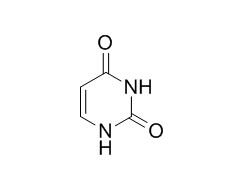Uracil
Uracil is a common and naturally occurring pyrimidine derivative and one of the four nucleobases in the nucleic acid of RNA, it can be used for drug delivery and as a pharmaceutical.
Inquire / Order:
manager@chemfaces.com
Technical Inquiries:
service@chemfaces.com
Tel:
+86-27-84237783
Fax:
+86-27-84254680
Address:
1 Building, No. 83, CheCheng Rd., Wuhan Economic and Technological Development Zone, Wuhan, Hubei 430056, PRC
Providing storage is as stated on the product vial and the vial is kept tightly sealed, the product can be stored for up to
24 months(2-8C).
Wherever possible, you should prepare and use solutions on the same day. However, if you need to make up stock solutions in advance, we recommend that you store the solution as aliquots in tightly sealed vials at -20C. Generally, these will be useable for up to two weeks. Before use, and prior to opening the vial we recommend that you allow your product to equilibrate to room temperature for at least 1 hour.
Need more advice on solubility, usage and handling? Please email to: service@chemfaces.com
The packaging of the product may have turned upside down during transportation, resulting in the natural compounds adhering to the neck or cap of the vial. take the vial out of its packaging and gently shake to let the compounds fall to the bottom of the vial. for liquid products, centrifuge at 200-500 RPM to gather the liquid at the bottom of the vial. try to avoid loss or contamination during handling.
Molecules.2023, 28(13):4971.
JPC-Journal of Planar Chromatography 2017, 30(4)
Cell Mol Biol (Noisy-le-grand).2023, 69(15):167-173.
Environ Toxicol.2020, doi: 10.1002
Molecules.2022, 27(7):2360.
Applied Biological Chemistry2022, 71:s13765-022-00743-5.
BMC Plant Biol.2021, 21(1):60.
Emirates Journal of Food and Agriculture.2022, 34(6): 528-536.
Chemistry of Plant Materials.2019, 129-136
The Japan Society for Analy. Chem.2017, 66(8):613-617
Related and Featured Products
J Biol Chem. 2015 Feb 27;290(9):5502-11.
Defective repair of uracil causes telomere defects in mouse hematopoietic cells.[Pubmed:
25572391]
Uracil in the genome can result from misincorporation of dUTP instead of dTTP during DNA synthesis, and is primarily removed by Uracil DNA glycosylase (UNG) during base excision repair. Telomeres contain long arrays of TTAGGG repeats and may be susceptible to Uracil misincorporation.
METHODS AND RESULTS:
Using model telomeric DNA substrates, we showed that the position and number of Uracil substitutions of thymine in telomeric DNA decreased recognition by the telomere single-strand binding protein, POT1. In primary mouse hematopoietic cells, Uracil was detectable at telomeres, and UNG deficiency further increased Uracil loads and led to abnormal telomere lengthening. In UNG-deficient cells, the frequencies of sister chromatid exchange and fragility in telomeres also significantly increased in the absence of telomerase.
CONCLUSIONS:
Thus, accumulation of Uracil and/or UNG deficiency interferes with telomere maintenance, thereby underscoring the necessity of UNG-initiated base excision repair for the preservation of telomere integrity.
J Biol Chem. 2014 Aug 8;289(32):22008-18.
Excision of uracil from transcribed DNA negatively affects gene expression.[Pubmed:
24951587]
Uracil is an unavoidable aberrant base in DNA, the repair of which takes place by a highly efficient base excision repair mechanism. The removal of Uracil from the genome requires a succession of intermediate products, including an abasic site and a single strand break, before the original DNA structure can be reconstituted. These repair intermediates are harmful for DNA replication and also interfere with transcription under cell-free conditions. However, their relevance for cellular transcription has not been proved.
METHODS AND RESULTS:
Here we investigated the influence of Uracil incorporated into a reporter vector on gene expression in human cells. The expression constructs contained a single Uracil opposite an adenine (to mimic dUTP misincorporation during DNA synthesis) or a guanine (imitating a product of spontaneous cytosine deamination). We found no evidence for a direct transcription arrest by Uracil in either of the two settings because the vectors containing the base modification exhibited unaltered levels of enhanced GFP reporter gene expression at early times after delivery to cells. However, the gene expression showed a progressive decline during subsequent hours.
CONCLUSIONS:
In the case of U:A pairs, this effect was retarded significantly by knockdown of UNG1/2 but not by knockdown of SMUG1 or thymine-DNA glycosylase Uracil-DNA glycosylases, proving that it is base excision by UNG1/2 that perturbs transcription of the affected gene. By contrast, the decline of expression of the U:G constructs was not influenced by either UNG1/2, SMUG1, or thymine-DNA glycosylase knockdown, strongly suggesting that there are substantial mechanistic or kinetic differences between the processing of U:A and U:G lesions in cells.
Phys Chem Chem Phys. 2014 Sep 7;16(33):17835-44.
Anionic derivatives of uracil: fragmentation and reactivity.[Pubmed:
25036757]
Uracil is an essential biomolecule for terrestrial life, yet its prebiotic formation mechanisms have proven elusive for decades. Meteorites have been shown to contain Uracil and the interstellar abundance of aromatic species and nitrogen-containing molecules is well established, providing support for Uracil's presence in the interstellar medium (ISM). The ion chemistry of Uracil may provide clues to its prebiotic synthesis and role in the origin of life. The fragmentation of biomolecules provides valuable insights into their formation. Previous research focused primarily on the fragmentation and reactivity of cations derived from Uracil.
METHODS AND RESULTS:
In this study, we explore deprotonated Uracil-5-carboxylic acid and its anionic fragments to elucidate novel reagents of Uracil formation and to characterize the reactivity of Uracil's anionic derivatives. The structures of these fragments are identified through theoretical calculations, further fragmentation, experimental acidity bracketing, and reactivity with several detected and potential interstellar species (SO2, OCS, CS2, NO, N2O, CO, NH3, O2, and C2H4). Fragmentation is achieved through collision induced dissociation (CID) in a commercial ion trap mass spectrometer, and all reaction rate constants are measured using a modification of this instrument.
CONCLUSIONS:
Experimental data are supported by theoretical calculations at the B3LYP/6-311++G(d,p) level of theory. Lastly, the astrochemical implications of the observed fragmentation and reaction processes are discussed.



